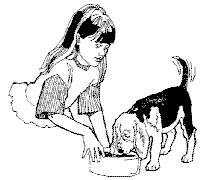| PETS
 Many
child care providers who care for children in their own homes have pets.
Pets can be excellent companions for children. Pets can meet emotional
needs of children and others for love and affection. Caring for pets also
gives children an opportunity to learn how to treat and be responsible
for others. However, some guidelines for protecting the health and safety
of the children should be followed. Many
child care providers who care for children in their own homes have pets.
Pets can be excellent companions for children. Pets can meet emotional
needs of children and others for love and affection. Caring for pets also
gives children an opportunity to learn how to treat and be responsible
for others. However, some guidelines for protecting the health and safety
of the children should be followed.
- All pets,
whether kept indoors or outside, should be in good health, show no evidence
of disease, and be friendly toward children.
- Dogs or
cats should be appropriately immunized (check with the veterinarian)
and be kept on flea, tick, and worm control programs. Proof of immunizations
should be kept in a safe place.
- Pet living
quarters should be kept clean. All pet waste should be disposed of immediately.
Litter boxes should not be accessible to children.
- Child
care providers should always be present when children play with pets.
- Children
should be taught how to behave around a pet. They should be taught not
to provoke the pet or remove the pet’s food. They should always
keep their faces away from a pet's mouth, beak, or claws.
- If you
have a pet in your child care facility, tell parents before they enroll
their child. Some children have allergies that may require the parents
to find other child care arrangements.
- Children
should wash their hands after handling pets or pet items.
- All reptiles
carry Salmonella. Therefore, small reptiles that might be handled by
children, including turtles and iguanas, can easily transmit Salmonella
to them. Iguanas and turtles are not appropriate pets for child care
centers.
- Some pets,
particularly “exotic” pets such as some turtles, iguanas,
venomous or aggressive snakes, spiders, and tropical fish, may not be
appropriate in the child care setting. Check with a veterinarian if
you are unsure whether a particular pet is appropriate for children.
Check with the local health department for regulations and advice regarding
pets in the child care setting.
|